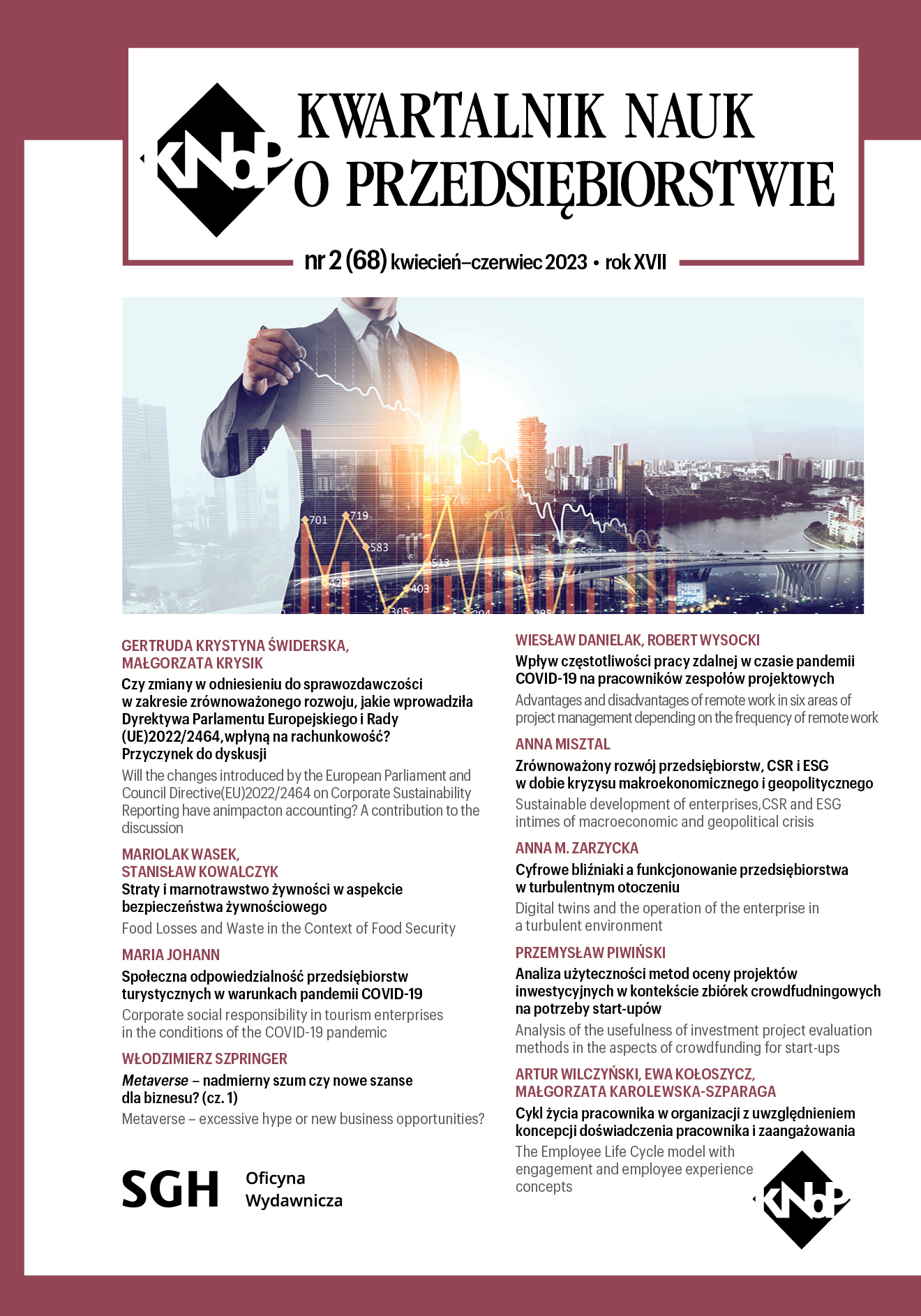Food Losses and Waste in the Context of Food Security
Main Article Content
Abstract
The article deals with food losses and waste – a global problem manifested along the entire agri-food chain. Food losses and waste during the deepening global food crisis caused by the current geopolitical situation and the COVID-19 pandemic contribute to food insecurity. Food shortages are a huge problem for millions of people suffering from hunger in the world, especially in developing countries on the African and Asian continents. The total amount of food wasted in the EU countries in 2020 is almost 57 million tons. In Poland, 4,8 million tons of food are wasted annually, while approximately 1.6 million people live in extreme poverty. Food losses and waste also put enormous pressure on natural resources, biodiversity, the natural environment, the economy and sustainable development, thus threatening food security. This problem was reflected in the EU strategies and the Sustainable Development Goals of the 2030 Agenda. Reducing food losses and waste will contribute to improving food security in the world and, at the same time, will reduce the pressure on the natural environment.
Downloads
Article Details

This work is licensed under a Creative Commons Attribution 4.0 International License.
The author of the article declares that the submitted article does not infringe the copyrights of third parties. The author agrees to subject the article to the review procedure and to make editorial changes. The author transfers, free of charge, to SGH Publishing House the author's economic rights to the work in the fields of exploitation listed in the Article 50 of the Act of 4 February 1994 on Copyright and Related Rights – provided that the work has been accepted for publication and published.
SGH Publishing House holds economic copyrights to all content of the journal. Placing the text of the article in a repository, on the author's home page or on any other page is allowed as long as it does not involve obtaining economic benefits, and the text will be provided with source information (including the title, year, number and internet address of the journal).
References
Banki Żywności (2022), Raport Federacji Polskich Banków Żywności 2022, Warszawa.
Banki Żywności (2019), Nie marnuj jedzenia 2019, Warszawa.
Decyzja delegowana Komisji (UE) 2019/1597 z dnia 3 maja 2019 r. uzupełniająca dyrektywę Parlamentu Europejskiego i Rady 2008/98/WE w odniesieniu do wspólnej metody i minimalnych wymagań jakościowych dla jednolitego pomiaru poziomów odpadów żywności (Dz.U. L 248 z 27.9.2019).
Dyrektywa Parlamentu Europejskiego i Rady (UE) 2018/851 z dnia 30 maja 2018 r. zmieniająca dyrektywę 2008/98/WE w sprawie odpadów.
EUROSTAT (2022a), https://ec.europa.eu/eurostat/databrowser/view/ilc_mdes03/default/table-?lang=en (dostęp: 20.12.2022).
EUROSTAT (2022b), https://ec.europa.eu/eurostat/databrowser/view/env_wasfw/default/table-?lang=en (dostęp: 15.01.2023).
EUROSTAT Statistics Explained (2022), https://ec.europa.eu/eurostat/statistics-explained/index.php?title=Food_waste_and_food_waste_prevention_estimates#Amounts_of_food_waste_at_EU_level (dostęp: 26.10.2022).
FAO (2022), SDG indicator metadata, https://unstats.un.org/sdgs/metadata/files/Metadata-12–03-01A.pdf (dostęp: 22.11.2022).
FAO (2011), Global food losses and food waste – Extent, causes and prevention, Rome.
FAO, IFAD, UNICEF, WFP, WHO (2022), The State of Food Security and Nutrition in the World 2022. Repurposing food and agricultural policies to make healthy diets more affordable, Rome, FAO.
FAO (2019), The State of Food and Agriculture 2019. Moving Forward on Food Loss and Waste Reduction, Rome.
GUS (2023), Oficjalne statystyki SDG – wskaźniki dla celów globalnych, Warszawa, https://sdg.gov.pl/assets/pdf/pl/2–1–2.pdf (dostęp: 23.01.2023).
GUS (2021), Ubóstwo w Polsce w latach 2019 i 2020, Warszawa.
HLPE (2014), Food losses and waste in the context of sustainable food systems. A report by the High Level Panel of Experts on Food Security and Nutrition of the Committee on World Food Security, Rome.
Holt-Giménez E., Shattuck A., Altieri M., Herren H., Gliessman S. (2012), We Already Grow Enough Food for 10 Billion People … and Still Can’t End Hunger, “Journal of Sustainable Agriculture”, Vol. 36, Issue 6, pp. 595–598.
Komisja Europejska (2020), Strategia „od pola do stołu” na rzecz sprawiedliwego, zdrowego i przyjaznego dla środowiska systemu żywnościowego, Bruksela.
KOWR (2021), Strategia racjonalizacji strat i ograniczania marnotrawstwa żywności, Warszawa, https://bip.mos.gov.pl/fileadmin/user_upload/bip/strategie_plany_programy/Krajowy_program_ zapobiegania_powstawania_odpadow.pdf (dostęp: 23.09.2022).
Krajowy program zapobiegania powstawaniu odpadów (2014), Warszawa, https://bip.mos.gov.pl/fileadmin/user_upload/bip/strategie_plany_programy/Krajowy_program_ zapobiegania_powstawania_odpadow.pdf (dostęp: 23.01.2023).
Kwasek M. (red.), Borowski M., Kowalewska M., Obiedzińska A. (2016), Z badań nad rolnictwem społecznie zrównoważonym [37]. Analiza strat i marnotrawstwa żywności na świecie i w Polsce, Monografie Programu Wieloletniego, nr 44, IERiGŻ PIB, Warszawa.
Munesue Y., Masui T., Fushima T. (2015), The effects of reducing food losses and food waste on global food insecurity, natural resources, and greenhouse gas emissions, “Environmental Economics and Policy Studies” 17, pp. 43–77.
Parfitt J., Barthel M., Macnaughton S. (2010), Food waste within food supply chains: quantification and potential for change to 2050, “Philosophical Transactions of the Royal Society B. Biological Sciences”, Vol. 365, pp. 3065–3081.
Rada Unii Europejskiej (2016), Marnotrawienie żywności i straty żywności – konkluzje Rady (28 czerwiec 2016 r.), Bruksela.
Rozporządzenie (WE) nr 178/2002 Parlamentu Europejskiego i Rady z dnia 28 stycznia 2002 r. ustanawiające ogólne zasady i wymagania prawa żywnościowego, powołujące Europejski Urząd ds. Bezpieczeństwa Żywności oraz ustanawiające procedury w zakresie bezpieczeństwa żywności (Dz.U. L 31 z 1.2.2002).
Szarfenberg R. (2022), Poverty Watch 2022. Monitoring ubóstwa finansowego i polityki społecznej przeciw ubóstwu w Polsce 2021–2022, Polski Komitet Europejskiej Sieci Przeciwdziałania Ubóstwu, Warszawa.
UNEP (2021), Food Waste Index Report 2021, Nairobi.
Ustawa z dnia 19 lipca 2019 r. o przeciwdziałaniu marnowaniu żywności [Dz.U. 2019, poz. 1680].
https://www.census.gov/ (dostęp: 31.01.2023).
https://www.fao.org/sustainable-development-goals/indicators/12.3.1/en/ (dostęp: 20.10.2022).
https://www.fao.org/platform-food-loss-waste/flw-data/user-guide/en/ (dostęp: 15.09.2022).

